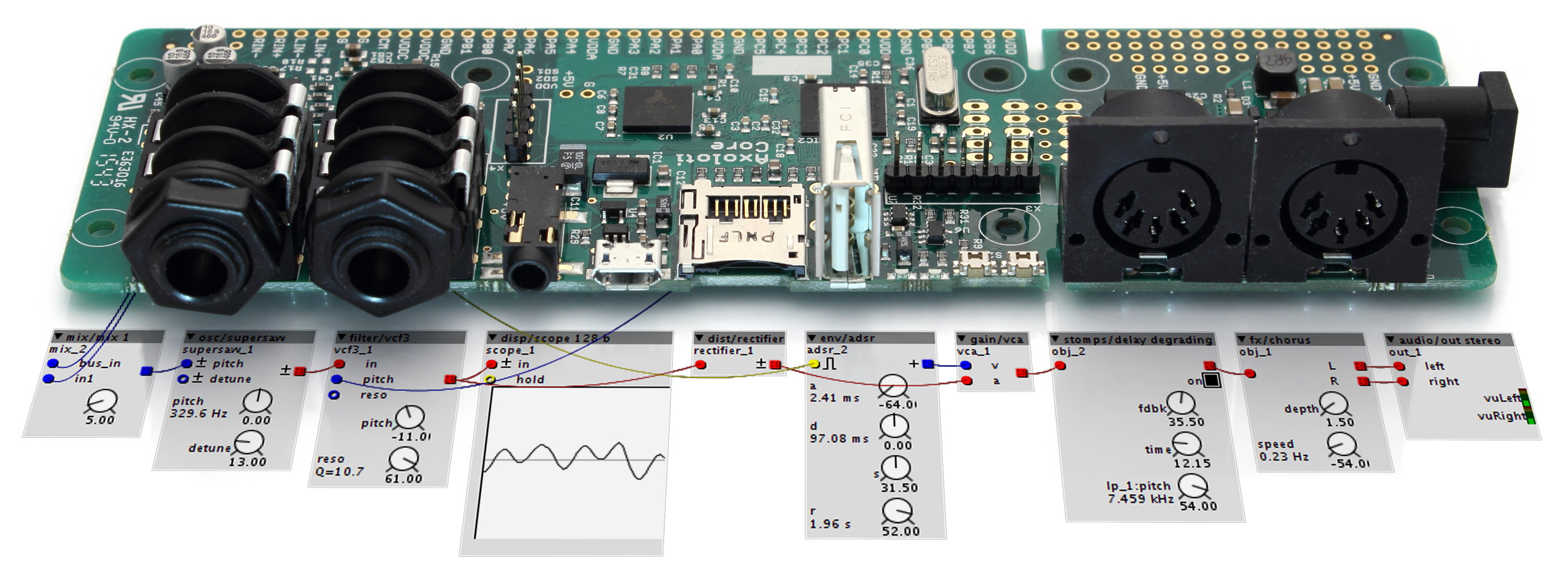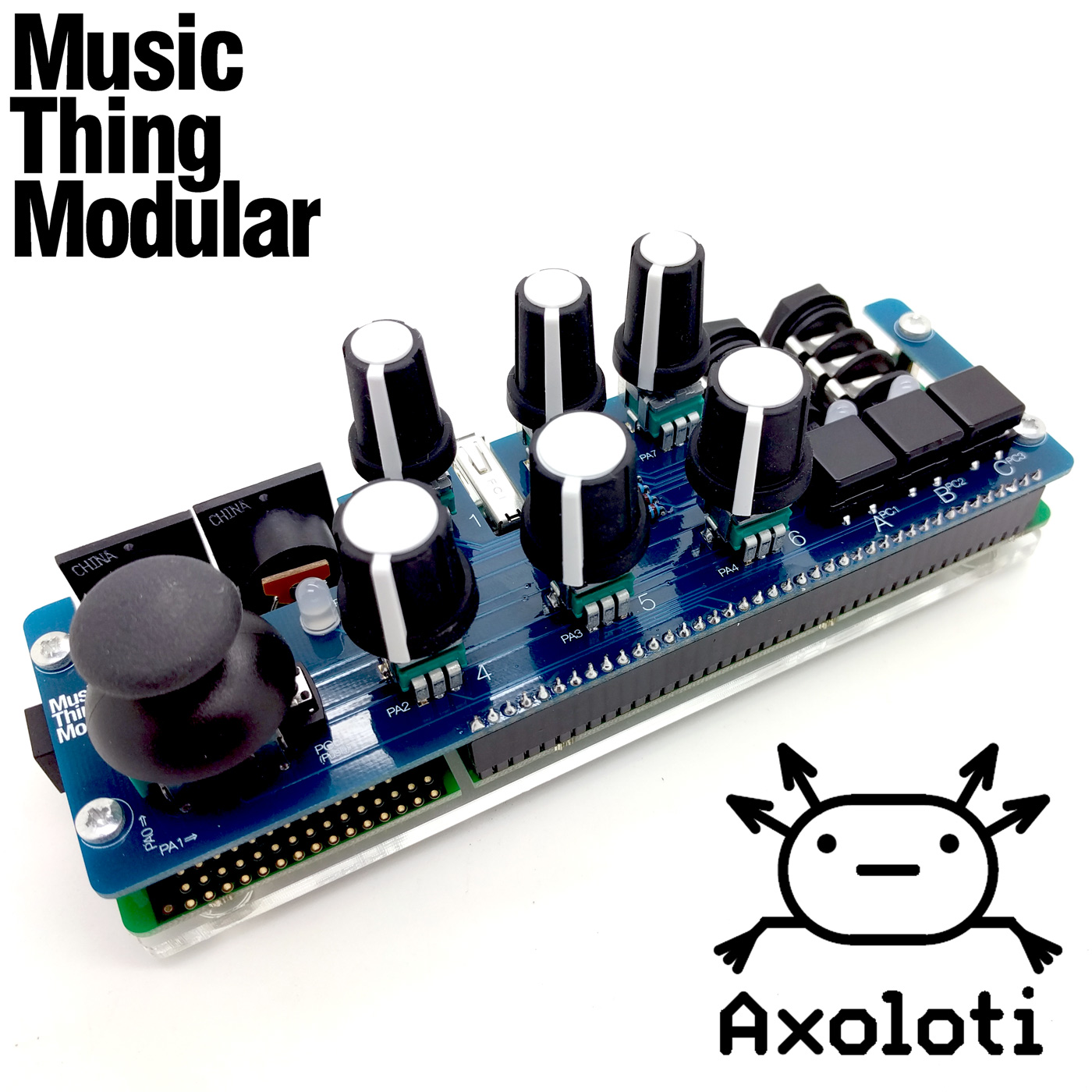Filter on ALL, SYNTH, DRUM, SAMPLER or MISC |
Total list currently 2405 items in 330 Brands |
Axoloti | Axoloti Core Synthesizer |
Description | “Axoloti Core” is a circuit board with stereo audio in- and output, audio analog-to-digital and digital-to-analog converters and a microcontroller suitable for digital audio processing. All connectors are on one side to make it easy to build your own tabletop device, rackmount, stompbox or something else. Connect to your PC or Mac, and start patching with the Axoloti Patcher. Disconnect from your PC and play your patch. The Axoloti patcher is the software part of Axoloti, and is a workbench to compose and edit your sound algorithms and interactions. After editing, patches can be stored in the Axoloti Core, and run without a computer connection. The Axoloti patcher object library currently offers oscillators (sine, alias-free saw, square, pwm, some noise generators, FM modulation), 1st order and 2nd order filters, envelopes, LFO’s, tables, Midi I/O, analog voltage input, PWM output, and streaming wave file playback from SDcard. The Axoloti patcher is written in Java and works on Windows (7 or later), OSX (10.7 minimum) and Linux. This GUI actually generates C++-code from the patch, then uses GCC to create binary executable code, and uploads the executable to the microcontroller, with one single mouse-click. After uploading, the patcher “locks” the patch architecture, and parameters in the patch can be adjusted in real-time on the screen (or from a midi controller). Axoloti Patcher features: + Seamless edit/compile/upload/adjust with a simple “live” button + Wire datatypes for booleans (yellow), integers (green), fractional numbers (blue), and audio fractional number buffers (red) + Seamless readback of live data in the patch: VU-meters, chart plotter, oscilloscope, spectrum analyzer… + Object “input type overloading”: objects can adapt to the type of connected inputs + Object selector with search + Cut/copy/paste (using plain text XML) + Midi mappable controls + Parameter modulation + Sub-patching (using a patch as an object in another patch) + Presets + Midi polyphonic voice allocation + Axoloti object library: Input/output + audio input + audio output + digital in (including optional pullup or pulldown configuration) + digital out (push-pull or open-collector) + analog in + digital PWM outputs LFO’s + sine + saw + square Oscillators + sine + saw + square + pulse-width modulation + saw with sync + square with sync Envelopes + AR + ADSR Filters + lowpass biquad + bandpass biquad + highpass biquad + lowpass 1st order + highpass 1st order MIDI + controller in + controller out + keyboard (incl. velocity, release velocity, polyphonic pressure) + bend in + bend out + channel pressure Mixer + 1,2,3,4… channel input mixer + crossfader Logic operators + Tables - similar as in Pure Data Effects + Echo + Delay lines - similar as in Pure Data + Soft saturate (non-antialiased) + infinite gain clipping (alias-free) Displays + VU-meter + chart-plotter + oscilloscope + bandpass-filter based spectrum analyzer (constant-Q) + FFT-based spectrum analyzer Math + Logarithm + Exponent + Square root + Reciprocal + Sine/cosine Hardware Specs: + Assembled circuit board + 168MHz STM32F427 microcontroller + 24bit/96kHz capable stereo audio ADC/DAC (editor and firmware currently only supports 24bit/48kHz) + 8MB SDRam + On-board switching power supply + Circuit board dimensions: 160 x 50 mm + 3mm mounting holes + Board revision 1.1 + Assembled and tested in Belgium Connections: + 1/4″ stereo input jack (line level with up to 55 dB digitally-controlled analog gain) + 1/4″ stereo output jack (digitally-controlled volume, DC-coupled) + 1/8″ headphone jack (same sound as the stereo output, independent volume) + MIDI input (5-pole DIN) + MIDI output (5-pole DIN) + Micro-SDCard slot + Micro-USB device port + Full size USB host port, supports USB-MIDI compliant devices. USB Hubs are not supported! + DC input (7-15V, 2.1mm center pin, center pin positive) + Solder pads for connecting potentiometers, faders, switches, LED’s… (16 signals, ground, 3.3V supply, 5V supply). + All I/O is 3.3V signalling. |
| Brand | Axoloti |
| Model | Axoloti Core Synthesizer |
| Device | Synth |
| Type | Desktop |
| Engine Type | Digital |
| Engine | VA |
| LFO | Saw Up, Sine, Square |
| Noise | Y |
| Engine Detailed | Pulse Variable, Saw Down, Saw Up, Sine, Square, Triangle, White Noise FM |
| Filter (VCF) | Band Limit, Band Pass, High Pass, Low Pass, Resonance |
| Envelope (VCA) | ADSR |
| FX | Delay, Distortion |
| Memory | Micro SD |
| Sequencer | 1-16 step |
| Keys | 0 |
| Key type | N/A |
| Velocity | N/A |
| Aftertouch | N/A |
| Audio | Stereo I-O, Digital I-O |
| Extra info | DIY |
| Produced: | 2015 |
| Legend: | Obvious | Y: Yes, N: No, N/A: Not Applicable | |
| VCO | Voltage Controlled Oscillator | DCO | Digital Controlled Oscillator |
| LFO | Low Frequency Oscillator | Sub | Sub Oscillator |
| VCF | Voltage Controlled Filter | VCA | Voltage Controlled Amplifier |
| Velocity | As with a piano, the harder you hit a key, the louder the sound, unlike most organs which always produce the same loudness no matter how hard you hit a key. | Aftertouch | Pressing a key after you activated it. Channel Aftertouch, no matter which key, it will send a Channel message. Poly Aftertouch, sends the pressure per key instead of the whole channel. |
| Values for OSC, LFO, Filter, Envelope are per voice unless stated otherwise. | |||





